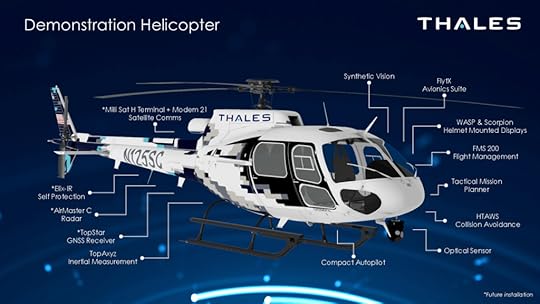Changing the game in flight testing; a helicopter that reconfigures avionics in-flight
With operating environments growing more complex and threats evolving faster than ever, it’s imperative for the Army and its vendors to field new capabilities at a relevant speed. This need to compress timelines and shrink development from years to months or even weeks is further fueled by the strategic use and integration of more off-the-shelf technology and rapid development of software updates.
As a result, the historic distinction between initial development and its in-service improvement is effectively being dissolved, creating a continuous, high-speed feedback loop between the battlefield and the factory floor.
Traditional in-flight testing of system improvements offers the most realistic performance data, but it comes with a slower timeline for tweaking performance issues and then scheduling another flight to test them. Changes can be made faster in a virtual test environment, but that can miss some of the complexities of a live flight in a real operating environment.
Thales has sought to remake the traditional in-flight paradigm by developing a test and demonstration helicopter that allows for capability iterations in real time, literally.
In creating this flying testbed, Thales hasn’t just changed how the company’s engineers can identify, fix and test performance issues on in-development technologies. It has improved how it interacts with its customers in defense, government, and civil aviation – allowing them to see a system perform in a live flight, provide real-time feedback data on its performance, and potentially see the next iteration during that same test flight.
The Thales Demonstration Helicopter is a modified Airbus H125 light helicopter (formerly named the Eurocopter AS350 Écureuil) that is meant to be both a testbed for the company’s new systems and a tool for direct engagement with customers.

The platform has a custom cockpit equipped with large display screens, the company’s compact four-axis autopilot, and helmet-mounted displays. It’s built on a modular open-architecture backbone that allows Thales to easily integrate its own hardware and software – or that of its collaborators in industry. And, importantly, it’s connected during flight to Thales engineers on the ground via a secure internet connection so the team can monitor the performance of systems undergoing flight testing and even upload software changes mid-flight.
“It gives us a rapid fly-fix-fly capability that’s very unique; there is nothing better than flying customers in the aircraft so they can see how technologies operate in real environments,” said Ryan Walters, US Army retired Special Operations Chief Helicopter Pilot and GM, Thales Flight Avionics US.
The rapid fly-fix-fly capability is enabled by an encrypted data link using a 5G commercial modem that allows the air crew to talk to and share data with engineers or customers anywhere in the world, according to Jim Sleigh, a Thales flight test engineer and pilot.
In one example, “during a demonstration, a customer suggested a change to one of our digital map products,” said Sleigh. “Over the phone, I was able to call an engineer at his desk who connected to the aircraft in real-time. The engineer said, ‘I think I know the problem: hang on, I’m taking control of the display.’ He changed the code, rebooted the display, and asked: ‘how does it look now?’ It was improved!
“At that moment, I realized that we had changed the paradigm, the fly-fix-fly, from what used to be weeks, days, to not hours but literally minutes. It’s a transformative capability for us and our customers in terms of development.”
This type of flying testbed could support incremental upgrades or security patches to Thales avionics, or the integration of entirely new products. Due to the modular open-architecture design, it also creates an opportunity to partner with other companies on integrated capability packages.
“This makes it easy for us to do something like fly someone else’s mission computer, software, or sensor,” Sleigh added. “Our software running on someone else’s hardware, for instance, is easy to do on this helicopter,” thereby improving Thales’ relationships with both the end users and the industry partners.
Customer feedback matters
If having this demonstrator is beneficial from a development and test perspective, it’s equally beneficial from a customer engagement perspective.
As with the digital map mentioned earlier, the company’s ability to communicate while in flight in the Thales Flight Demonstration Helicopter, get real-time feedback, and write and upload new code even before the helicopter lands can be considered revolutionary. An Army test engineer could have been on the flight, seen a system feature or behavior that wasn’t quite what the Army wanted, and had the Thales team on the ground start engineering a fix right away.
Importantly, Walters noted, feedback isn’t being relayed from an Army operator through an Army engineer to a Thales engineer to the Thales business development team. “It’s us flying with our customers for immediate feedback.”
As a former Army aviator, Walters said this could also be a major shift in how industry understands and responds to customer needs.
“Our number one priority is enhancing safety, improving situational awareness, and getting the customer’s thumbprints on our products so that we’re not developing stuff just to requirements or in a vacuum. We’re focused on what the end-user customer and the program offices have to say. They get to actually see that their feedback matters.”
A tangible investment in the US market
The idea for the Thales Flight Demonstration Helicopter surface in 2020 when Thales partnered with StandardAero to integrate its compact autopilot system onto an Airbus H125 and complete a test and evaluation plan to achieve FAA flight certification, allowing Thales to sell its autopilot package to light helicopter operators.
“At the completion of that program, we were reflecting on the helicopter not flying anymore, and the vision came to us that we should repurpose this helicopter as a Thales flying testbed and demo platform,” Sleigh explained.
He noted that on the surface some competitors have a similar demonstrator, but this flying testbed is unique as a “fully integrated, fully mission-representative integrated cockpit platform.”
The future of Army aviation will be modular integrated avionics, according to Walters, where Thales may need to ensure its capabilities can operate seamlessly with partner companies’ products. This modular testbed, designed to demonstrate MOSA compliance, allows Thales and others in industry to collaborate and internally work through interoperability challenges that give the Army confidence that an integrated avionics package will work as planned once installed on a military aircraft.
Said Sleigh: “We’re making investment in tangible terms and now have a platform to invite partners to come fly and bring their technology aboard.”
“We are part of the equation to reduce risk and enhance safety and can do that through the iterative processes we have with our aircraft to incorporate what we think the customer needs with real time feedback,” said Walters. “At the end of the day, the warfighter deserves the best capabilities industry can provide. We want people to use our solutions because they trust them and it enhances safety and reduces risk, and they get to come home safely each night.”
For more information about the Thales Demonstration Helicopter, visit our website.
Douglas A. Macgregor's Blog
- Douglas A. Macgregor's profile
- 28 followers



